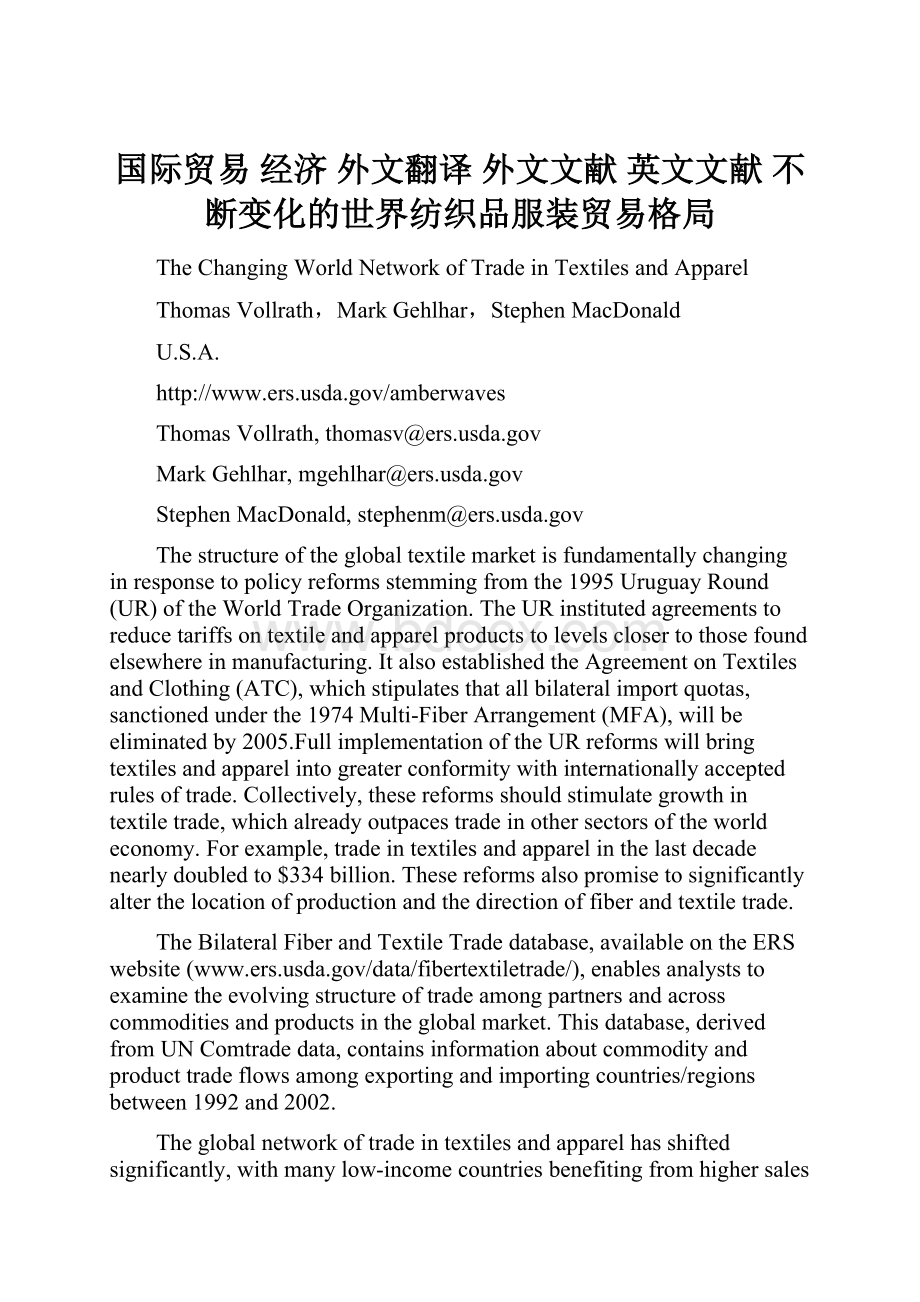国际贸易 经济 外文翻译 外文文献 英文文献 不断变化的世界纺织品服装贸易格局.docx
《国际贸易 经济 外文翻译 外文文献 英文文献 不断变化的世界纺织品服装贸易格局.docx》由会员分享,可在线阅读,更多相关《国际贸易 经济 外文翻译 外文文献 英文文献 不断变化的世界纺织品服装贸易格局.docx(8页珍藏版)》请在冰豆网上搜索。

国际贸易经济外文翻译外文文献英文文献不断变化的世界纺织品服装贸易格局
TheChangingWorldNetworkofTradeinTextilesandApparel
ThomasVollrath,MarkGehlhar,StephenMacDonald
U.S.A.
http:
//www.ers.usda.gov/amberwaves
ThomasVollrath,thomasv@ers.usda.gov
MarkGehlhar,mgehlhar@ers.usda.gov
StephenMacDonald,stephenm@ers.usda.gov
Thestructureoftheglobaltextilemarketisfundamentallychanginginresponsetopolicyreformsstemmingfromthe1995UruguayRound(UR)oftheWorldTradeOrganization.TheURinstitutedagreementstoreducetariffsontextileandapparelproductstolevelsclosertothosefoundelsewhereinmanufacturing.ItalsoestablishedtheAgreementonTextilesandClothing(ATC),whichstipulatesthatallbilateralimportquotas,sanctionedunderthe1974Multi-FiberArrangement(MFA),willbeeliminatedby2005.FullimplementationoftheURreformswillbringtextilesandapparelintogreaterconformitywithinternationallyacceptedrulesoftrade.Collectively,thesereformsshouldstimulategrowthintextiletrade,whichalreadyoutpacestradeinothersectorsoftheworldeconomy.Forexample,tradeintextilesandapparelinthelastdecadenearlydoubledto$334billion.Thesereformsalsopromisetosignificantlyalterthelocationofproductionandthedirectionoffiberandtextiletrade.
TheBilateralFiberandTextileTradedatabase,availableontheERSwebsite(www.ers.usda.gov/data/fibertextiletrade/),enablesanalyststoexaminetheevolvingstructureoftradeamongpartnersandacrosscommoditiesandproductsintheglobalmarket.Thisdatabase,derivedfromUNComtradedata,containsinformationaboutcommodityandproducttradeflowsamongexportingandimportingcountries/regionsbetween1992and2002.
Theglobalnetworkoftradeintextilesandapparelhasshiftedsignificantly,withmanylow-incomecountriesbenefitingfromhighersaleswithinthepastdecade.Unlikeagriculturalproduction,whichdependsontheavailabilityofnaturalresources,thelocationoftextileand,particularly,apparelproductionishighlymobileandextremelyresponsivetowagedifferentials.Textileandapparelproductionrequiressubstantiallabor,isnottechnologicallydemanding,andprovidesemploymentopportunitiesfortherelativelyunskilledlaborerswhotransferoutofsubsistenceagriculture.Itintroducesworkerstomanufacturingandprovidesthemwithtrainingopportunitiesinnewandproductivity-enhancingactivities.
Competitionfromlow-costsuppliersindevelopingcountrieshasputconsiderablepressureonestablishedexportersoftextilesandapparel,particularlythoseinthenewlyindustrializedcountries(NIC)ofAsia(HongKong,Macau,Singapore,SouthKorea,andTaiwan).TheAsian-NICshareoftheglobaltextileandapparelmarkethalved,fallingfrom24to12percentbetween1992and2002.Incontrast,themarketshareofdeveloping-countrysuppliers,excludingtheAsianNICs,increased15percentagepointsto64percentduringthisperiod.Chinawasespeciallysuccessful,raisingitsshareoftheglobalmarketto25percentin2002,up4percentagepointsfrom1992.Suchcompetitivepressuresfromlow-cost,developing-countrysuppliersarelikelytoacceleratefollowingtheeliminationofMFAquotasby2005.
Textileandappareltradeisstronglyinfluencedbyestablishednetworksandgeographicalproximity.Together,Africa,theMiddleEast,andEasternEuropedominatetheEUmarketbecauseofpreferentialtradingagreementsandtheeconomicsofgeographicallocation.Incontrast,themostimportantsupplierstotheUnitedStatesareLatinAmerica,China,andtheAsianNICs.WithimprovedmarketaccessfromtheATC,low-incomeAsianproducersarelikelytoviemoreeffectivelywiththesetraditionalsuppliersforforeignmarketsharesintheU.S.andEUmarkets.
TheURreformsareexpectedtoreducepricesfortextilesandapparel,increasingworldwidedemandforproductsthroughoutthefiber-to-clothingsupplychain.Demandfortextileandapparelimportsisalreadyrisingrapidlyamongtheindustrializedcountries(IC).ThisdemandisparticularlystrongamongimportersusingMFAquotas(Canada,EU,Norway,andtheUnitedStates).AsconsumerpricesfallduetoATCreforms,importsofclothing,bedlinen,carpets,andotherproductsarelikelytocontinuetoincrease.Envisionedshiftsinsupplyanddemandfortextileandapparelwillenhancelaborproductivityinthedevelopingcountries,leadingtoincomegrowthandgreaterglobaldemandforagriculturalproducts,includingfoodandrawfibers,suchascotton.
不断变化的世界纺织品服装贸易格局
托马斯·瓦拉斯,马克·葛赫哈,史蒂芬·麦克通纳德
美国
http:
//www.ers.usda.gov/amberwaves
托马斯·瓦拉斯,thomasv@ers.usda.gov
马克·葛赫哈,mgehlhar@ers.usda.gov
史蒂芬·麦克通纳德,stephenm@ers.usda.gov
全球纺织品市场结构是根据1995年世界贸易组织举行的乌拉圭回合的政策改革而发生着根本性的变化。
乌拉圭回合提议将纺织品和服装产品的关税降低到与这些生产国的关税比较接近的水平。
它同样确立了纺织品与服装协定(ATC),ATC是保证在1974年多种纤维协定(MFA)下制定的所有的双边进口配额将会在2005年被取消。
乌拉圭回合改革的全部实现将使得纺织品和服装与国际上公认的贸易规则更加地一致。
总的来说,这些改革应该促进纺织品贸易的增长,这种增长会超过世界经济体中其它部门贸易的增长。
譬如,纺织品和服装贸易在过去的十年中几乎翻了一倍达到3340亿美元。
这些改革同样预示着纤维和纺织品贸易的生产地点和方向将会发生重大改变。
ERS网站(www.ers.usda.gov/data/fibertextiletrade/)提供的双边纤维和纺织品贸易数据库,能使分析家了解全球市场中合作伙伴之间和跨商品和产品之间正在演进的贸易结构。
这个数据库,来源于联合国的Comtrade数据,它包括出口和进口国家/地区在1992年到2002年之间的有关商品和产品贸易流的信息。
纺织品和服装贸易的全球格局已经发生了重大的变化,同时在过去的十年间许多低收入国家从更大的贸易销售中获利。
与依赖自然资源禀赋的农业产品不同,纺织品生产的地点,特别是,服装的生产地点由于工资的差异在不断地转移。
纺织品和服装的生产需要大量的劳动力,这种生产并不是技术性的生产需求,而是为大量从农业中转移出来的相对缺乏技术能力的劳动者提供就业的机会。
它使工人们学会生产制造,并且提供给他们在新的并且生产效率不断提高的领域内培训的机会。
不断变化的全球纺织品和服装出口国格局
来自发展中国家低成本供给的竞争已经给原有的纺织品和服装的出口国施加了相当大的压力,特别是对于那些亚洲的新兴工业化国家(香港、澳门、新加坡、韩国和台湾)。
亚洲新兴工业化国家在全球纺织品和服装市场所占的份额减少了一半,从1992年的24%下降到2002年的12%。
相反,除亚洲新兴工业化国家以外,发展中国家的供应商所占的市场份额在这段时期内增加了15%达到了64%。
其中中国取得了显著的进步,在2002年所占全球的市场份额高达25%,比1992年上升了4个百分点。
来自低生产成本、发展中国家供应商的竞争压力可能会加速多种纤维协定所要求的在2005年完成配额的取消。
正在变化的格局:
一些供应商正在失去市场份额而另一些供应商正在增加他们的市场份额
纺织品和服装贸易很容易受已确定的格局和相邻的地理条件的影响。
譬如,非洲、中东和东欧在欧盟市场上占主导地位,是因为特惠贸易协定和地理分布的经济性。
相反,美国最重要的进口来源国是拉丁美洲国家,中国和亚洲的工业化国家。
随着纺织品与服装协定下市场的不断扩大,亚洲的低收入生产商可能和那些传统的供应商在美国和欧盟市场上展开更加有效的竞争来争夺这些国家的市场份额。
人们希望乌拉圭回合的改革能降低纺织品和服装的价格,通过纤维服装供应链来增加全球对这些产品的需求。
在工业化国家中对纺织品和服装进口的需求在快速地增长。
这种需求的增长在使用多种纤维协定规定下的配额制的进口国(加拿大、欧盟、挪威和美国)中表现地非常明显。
由于纺织品与服装协定的改革使得消费者的价格下降,服装、床上亚麻纺织品、地毯和其他产品的进口很可能继续增加。
纺织品和服装的供给和需求潜在的变化将要提高发展中国家的劳动生产效率,促进收入的增长和全球农产品需求的扩大,这些农产品包括食物和纤维原材料,比如棉花。